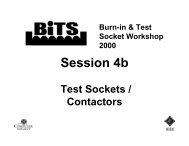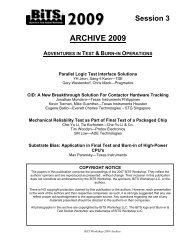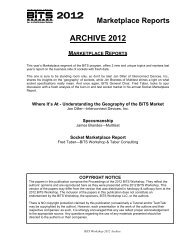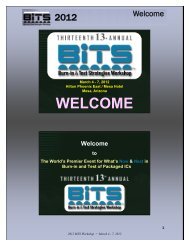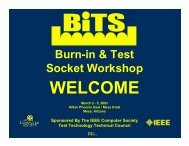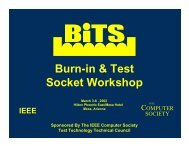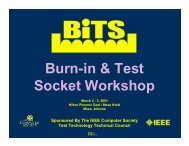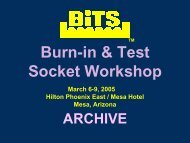Burn-in & Test Socket Workshop - BiTS Workshop
Burn-in & Test Socket Workshop - BiTS Workshop
Burn-in & Test Socket Workshop - BiTS Workshop
You also want an ePaper? Increase the reach of your titles
YUMPU automatically turns print PDFs into web optimized ePapers that Google loves.
Experimental Detail / Analysis<br />
Stage 4 Summary<br />
‣ Contact Resistance (1.0mm)<br />
‣ Increases <strong>in</strong> contact<br />
resistance with and without<br />
bias over time <strong>in</strong> all cases<br />
‣ No significant difference<br />
between:<br />
‣ Pb and No Pb samples<br />
‣ Bias and No Bias cha<strong>in</strong>s<br />
‣ PdNi worse <strong>in</strong> all cases than<br />
Au<br />
‣ Difference between Au<br />
and PdNi visible,<br />
possibly because of<br />
fresh devices at each<br />
read<strong>in</strong>g?<br />
‣ 125% force appears to lower<br />
overall contact resistance<br />
rate of <strong>in</strong>crease over time on<br />
both plat<strong>in</strong>g types<br />
Log Resistance (O)<br />
100<br />
10<br />
1<br />
0<br />
No Pb<br />
Contact Resistance - 1.0mm<br />
Pb<br />
0 24 72 168 504 0 24 72 168 504<br />
Au – 100% W/ Bias PdNi – 100% W/ Bias<br />
Au – 125% W/ Bias PdNi - 125% W/ Bias<br />
Au - 100% PdNi - 100%<br />
Au - 125% PdNi - 125%<br />
The Effects of No Lead Solder Balls on <strong>Burn</strong>-<strong>in</strong> <strong>Socket</strong> Design Decisions Page 21



